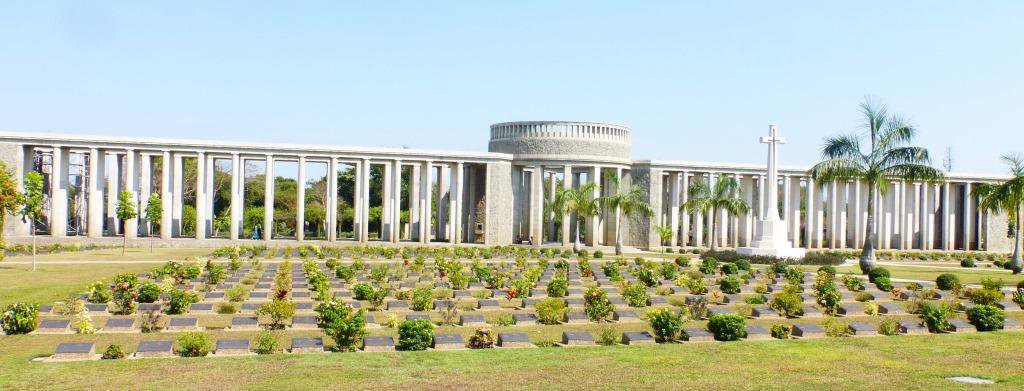10 February 2025
Commonwealth War Graves in the Second World War: New War, New Challenges
With the outbreak of the Second World War, the then-Imperial War Graves Commission was facing a new set of challenges.
Commonwealth War Graves in the Second World War
The interwar years

Image: Gardeners planting at Lijssenthoek Military Cemetery, Belgium, in the 1920s
From its grassroots beginnings, the Imperial War Graves Commission, the first incarnation of our organisation, was now a well-established organisation.
The 1920s was a very busy period for the Commission. The design and atmosphere of our war cemeteries and memorials had been meticulously devised and executed globally.
All over the former battlefields of the Great War, scattered graves had been consolidated where their commemoration in perpetuity could be ensured through our work.
Whilst remains continued to be recovered after the war ended, vast memorials to the missing were also erected to commemorate those with no known grave. The Commission’s principles and immense task was now firmly established.
By the 1930s, as the political situation in Europe turned febrile, the Commission’s main focus was maintaining its cemeteries and memorials.
The last of the great First World War memorials to the Missing, the Australian National Memorial in Villers-Bretonneux, was inaugurated in the summer of 1938.
It was hoped that, with that, the Commission would never have to build a new cemetery or memorial again. But, just over a year later, Europe and the world were plunged into conflict once again.
A new war
Hitler’s invasion of Poland in September 1939 triggered the French and British declarations of war on Nazi Germany. The British Dominions of India, New Zealand, Australia, South Africa, and Canada soon followed suit.
European tranquillity was smashed. What started in Europe would eventually grow into an all-encompassing World War.
Commission headquarters and regional offices were forced to relocate. Gardeners and caretakers still caring for our sites did what they could with dwindling resources, though efforts were made to evacuate staff where possible.
In some cases, Commission staff were arrested and sent to civilian internment camps deep into Germany. Suffering disease, squalor and hardship, these staff members endured terrible hardships.
For example, Gardener-Caretake Charles Henry Holton died in captivity and is commemorated with a Commission headstone.
At the beginning of the war, and as it drew on and grew, Commission staff and the general public wondered what challenges this new conflict would bring.
Preservation in an age of destruction

Image: Firefighters tackling blazing buildings as London suffers through the Blitz (© IWM (HU 1129)
The pressures brought about by the outbreak of the Second World War exacerbated the challenges the Commission faced in safeguarding its extensive records.
Now, our war casualty database is almost entirely digital, having brought our records online. But at the time of the Second World War, the Commission was still dealing with masses of paper files.
With the Luftwaffe pioneering area bombing of cities in the Spanish Civil War, civilian and military leaders understood a modern war could see British cities targeted.
The Commission was apprehensive of the threat bombing posed to the records located at its headquarters in London.
Acting proactively, the Commission began exploring alternative storage locations in 1938 for its precious papers to remove them out of harm’s way.
John Arundell, 16th Baron Arundell of Wardour, a member of the House of Lords and an officer in the Wiltshire Regiment, was asked if he would store Commission records in New Wardour Castle, his family home, for safekeeping.
 Image: Letter from the Commission thanking Lord Arundell for allowing the storage of Commission records in New Wardour Castle
Image: Letter from the Commission thanking Lord Arundell for allowing the storage of Commission records in New Wardour Castle
Lord Arundell consented but was soon involved in the fighting himself. He went to France with 2nd Battalion, Wiltshire Regiment, as part of the BEF but was captured in 1940 following the fall of France.
During Lord Arundell’s captivity, the Commission wrote to his mother, Lady Ivy Arundell, asking whether Wardour could keep accommodating its papers. Graciously, Lady Arundell accepted.
Sent to the infamous Oflag IV-C, aka Colditz, Lord Arundell had a habit of exercising in the East German snow. It is believed his external exercise contributed to the Baron contracting tuberculosis.
He was repatriated in accordance with the Geneva Convention and died in hospital in Chester. Buried in the chapel at New Wardour Castle, Lord Arundell is commemorated by the Commonwealth War Graves Commission.

Image: Imperial War Graves Commission UK locations circa 1938
The destruction caused by the Blitz went to show the Commission was wise to evacuate a portion of its collection to the country.
Indeed, the War Office distressingly lost its Great War soldiers' records to fire following bombing, losing precious service records and leaving the country with only a fraction of the full set.
Not all of the Commission’s records were left unscathed, however. The war caused a great demand for paper for munitions and the British Government sought utilising the paper from archival repositories to support the war efforts.
These factors, which contrast with the modern view that prioritises and values preserving historically significant records, led to the decision to pulp a significant portion of Commission First World War enquiry files, namely those where no correspondence had taken place since 1 January 1932.

Want more stories like this delivered directly to your inbox? Sign up for our newsletter for regular updates on the work of Commonwealth War Graves, blogs, event news, and more.
Sign UpNew war, new casualties, new commemorations
“After the lapse of many years the Commission is once more going into business on a large scale”- Lieutenant Colonel Sir Herbert Ellissen, IWGC Chief Financial Officer

Image: Men of the 48 Graves Concentration Unit place temporary wooden grave markers in a Commission Normandy cemetery
Of course, one of the clear challenges facing the Imperial War Graves Commission in the Second World War was the recording of the war dead and providing for their commemoration.
In the first year of the war, the United Kingdom alone lost 66,000 men. These would soon mount exponentially.
By the end of the Second World War, over 667,000 men and women of the armies, air forces, navies, and merchant fleet of the British Empire had died in service.
Building upon its experiences from the First World War and the founding principles laid down in the aftermath, the Commission planned ahead in selecting land for use as cemeteries for the Second World War for when the fighting had ended. However, it faced considerable and unprecedented challenges posed by this latest conflict.
Fighting had raged in a variety of landscapes, terrains, and countries, stretching across the globe. One key challenge facing the Commission was establishing cemeteries and memorials in new and often remote locations around the world where it had neither the sufficient manpower nor infrastructure in place.
While the forces of the British Empire had been engaged in Europe, Africa, and the Middle East during the Great War, in the post-Second World War landscape, the Commission now had responsibilities in far-reaching and often inhospitable places.

Image: Architect's drawing of El Alamein War Cemetery, Egypt
For instance, the deserts of North Africa posed new horticultural questions of the Commission’s cemetery architects. Could the look and feel of country English gardens, the style established after the Great War, work in such arid landscapes? Which plants could thrive in such an environment? What would irrigation look like?
In the Far East, combat had raged in the mountainous jungle highlands of Burma, the urban streets of Hong Kong and Singapore, and the islands of the Pacific. Servicemen were taken as prisoners of war too, kept in squalid conditions and worked to death by their cruel captors. How best to commemorate men fighting in such disparate locations? How to bring in isolated graves or even find them?
Then there was a call for new war WW2 memorials too. The air forces of the British Empire had been greatly expanded and played a vital role in this most modern of wars.
With this air force expansion came a much larger number of losses. The Commission commemorates some 10,700 First World War airmen. The number of Second World War air force personnel commemorated is almost 10 times higher. Bomber Command alone suffered around 45% losses, around 57,000 men, for example.

Image: Original architectural plans for the Runnymede Memorial entrance
Due to the nature of aerial combat, be that dog fights, bombing missions, aerial recon, air auxiliary services and so on, meant being shot down over enemy territory or at sea. Often their bodies were not easily recoverable. These would have to be commemorated via newly built war memorials.
The forces of the British Empire were multicultural and multi-faith, which the Commission had to take into careful consideration of its forms of commemoration. For some, such as Hindus and Sikhs, cremation is preferable to burial, thus leaving no remains for WW2 war graves if chosen to be cremated, again requiring special memorials to commemorate these men.
The design of these cremation memorials was devised by Edward Maufe, R.A., the Commission’s Chief Architect and Artistic Adviser, succeeding in the role originally undertaken by Sir Frederic Kenyon.
Compared to the First World War, consideration was also given to commemorating the increased number of civilian casualties, with Winston Churchill backing Sir Fabian Ware’s proposal for the Commission to create and maintain a record of Commonwealth civilian war dead.
This resulted in a supplemental charter being organised in addition to the original Royal Charter which empowered the Commission to carry out these duties alongside its existing mandate. The resulting Civilian War Dead Roll of Honour was placed in Westminster Abbey.
Discover more of our history in the Commonwealth War Graves Commission Archive
The Commonwealth War Graves Commission archive tracks the history of the CWGC from our founding in 1917 to the present day.
Featuring meeting notes, blueprints, architectural designs, and much, much more, you can discover our story as it unfolded throughout the years.
The archive is available to view online with more files being regularly digitised for public availability. What will your research uncover?
With thanks to Commonwealth War Graves Commission Chief Archivist Michael Greet.

